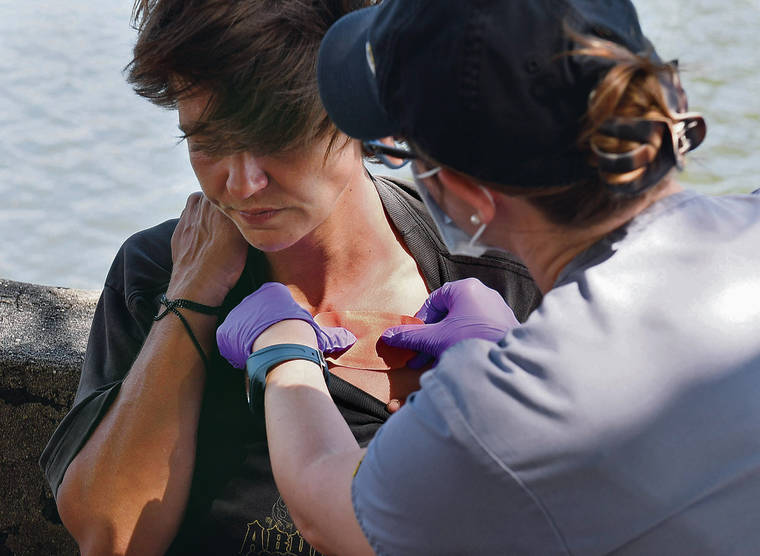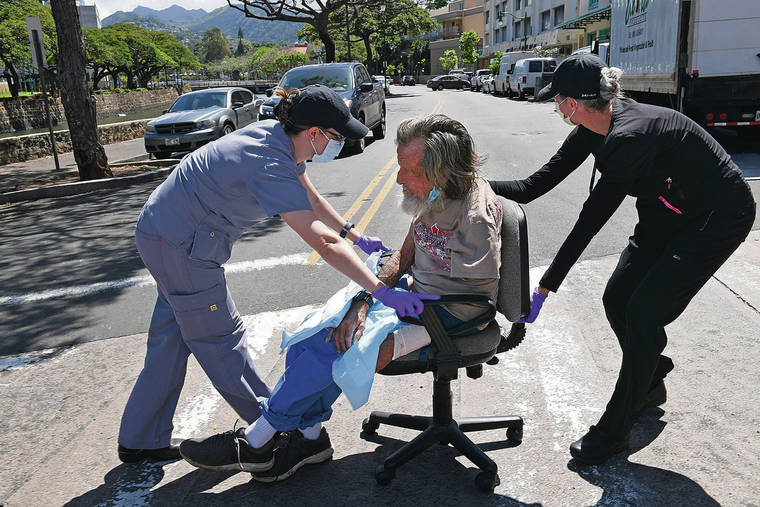Hawaii officials brace for ‘big surge’ of newly homeless from coronavirus shutdowns

BRUCE ASATO / BASATO@STARADVERTISER.COM
Dr. Christina Wang of the Hawaii Health and Harm Reduction Center applied an adhesive bandage on a cigarette burn on Heather Fell’s chest Friday on a River Street sidewalk in Chinatown.

BRUCE ASATO / BASATO@STARADVERTISER.COM
Dr. Christina Wang and nurse practitioner Courtny Tanigawa of the Hawaii Health and Harm Reduction Center rolled Tom Griffin in his office chair across a crosswalk at River Street in Chinatown on Friday to help him deal with his living situation.

BRUCE ASATO / BASATO@STARADVERTISER.COM
Nurse practitioner Courtny Tanigawa wrapped a bandage around the rib cage of Sam Bajwa on a walkway adjacent to the Chinatown Cultural Plaza on Friday.

BRUCE ASATO / BASATO@STARADVERTISER.COM
Dr. Christina Wang and nurse practitioner Courtny Tanigawa of the Hawaii Health and Harm Reduction Center dressed Terrance Gora’s leg wound.




Out of approximately 6,500 homeless people across all islands, only one so far has tested positive for the new coronavirus Opens in a new tab, but officials worry that an even bigger homeless problem could explode out of the financial devastation already hitting the state.
State, county and non-profit groups across Hawaii continue the work of trying to get chronically homeless people off the street while bracing for “a big surge” of people who may soon become homeless as workers are furloughed or laid off, or face salary cuts, said Laura Thielen, executive director of Partners in Care.
“Hopefully it won’t be too bad,” she said. “But it’s not looking too good right now.”
Even worse, people who become newly homeless “won’t meet the requirements for some of our current programs because they won’t be deemed as chronically homeless,” Thielen said.
She is part of groups of nonprofit, state and county officials meeting regularly to address Hawaii’s current — and future — homeless problems once the coronavirus pandemic ends. One group that meets every Monday morning sometimes includes as many as 420 participants, said Scott Morishige, the state’s homeless coordinator.
One of the many key issues being discussed, Thielen said, is “how we can quickly get them into housing.”
Don't miss out on what's happening!
Stay in touch with breaking news, as it happens, conveniently in your email inbox. It's FREE!
Marc Alexander, executive director of the city’s Office of Housing, said every idea is under consideration.
“No stone is being unturned,” he said. “Every option is on the table.”
Coming surge
On Friday, Gov. David Ige issued a supplementary emergency proclamation that bans evictions through April 30. State Attorney General Clare Connors told the Senate Special Committee on COVID-19 that an extension beyond April would likely be authorized next week.
Ige’s proclamation followed last week’s report by the state Department of Labor and Industrial Relations that 37% of Hawaii’s work force had filed 244,330 unemployment claims since March 1.
The thought of the human toll of what all those unemployment claims might mean — including families joining Hawaii’s homeless — “keeps me up at night … worrying about the crisis after the crisis,” said Eddie Mersereau, deputy director of the state Department of Health.
Perhaps even more ominously, the state’s homeless budget of more than $25 million a year is entirely reliant on the state’s general fund, which is driven by tax revenue from Hawaii’s shrinking economy.
The money pays for a litany of programs across the entire homeless spectrum, including: emergency and transitional homeless shelters; outreach to help the homeless on the street; so-called rapid re-housing to get newly homeless people re-housed; and the so-called Housing First program that places the most chronically homeless people into market-rate rental units, Morishige said.
While Morishige and other officials are working to prepare for a wave of newly homeless people, “In the worst case there might be cuts,” he said.
Not out of the woods
City and state officials have long feared COVID-19 outbreaks among homeless encampments, but flare-ups have yet to materialize.
One homeless person on Maui left a homeless shelter for treatment at Maui Memorial Hospital for an unrelated issue and was infected by the coronavirus at the beleaguered hospital — where 42 cases are under investigation, including 27 employees and 15 patients, Morishige said.
Even before the pandemic reached the islands, concerns had been growing about the possibility of coronavirus outbreaks among Hawaii’s homeless encampments because of lack of proper sanitation and hygiene.
In response, state, county and other organizations quickly opened Hawaii’s first triage and quarantine center for homeless people — nicknamed “Kaaahi” because of its street location in Iwilei.
Since the 26-bed building opened on April 1, 20 homeless people suspected of contracting COVID-19 have been examined. All but seven tested negative and the rest are in quarantine at Kaaahi awaiting their results, said nurse practitioner Christina Wang of the Hawaii Health and Harm Reduction Center.
“We’re not overly inundated by any means,” Wang said.
Mersereau cautioned, however, “While it is great that we’re not seeing the high numbers we were worried about, we’re not out of the woods yet.”
On Friday — as they do every Tuesday and Friday — Wang, nurse practitioner Courtny Tanigawa and tobacco treatment specialist Mono Ah Nee-Bahn fanned out throughout Chinatown to provide “advanced wound care” for homeless and low-income residents.
Each day they treat 15 to 20 patients on the street for a range of problems, including substance abuse, abscesses, amputation sites and minor and potentially serious issues.
Terrance Gora, 37, has been helped by the team before for a variety of issues, including a serious wound on his left leg that won’t get better.
Asked what happened, Gora told the Honolulu Star-Advertiser, “I don’t know. I think I was bit by a spider. It didn’t heal.”
Up and down River Street, Wang, Tanigawa and Ah Nee-Bahn were praised by all of the same faces they see each week, including Tom Griffin, 69, who sat in a black office chair wearing hospital pants and a Queen’s Medical Center patient bracelet on his right wrist.
Griffin had just been discharged from Queen’s the night before after being attacked and beaten with a metal pipe by strangers.
They beat on Griffin from his left shoulder to his left wrist and made off with his wheel chair. The assailants also stole Griffin’s last $2.
“I need help,” he moaned at the corner of River and Hotel streets, while sitting on his discharge papers from Queen’s.
“The blood was all over the place,” he said.
Assistance dwindles
The work by the team from Hawaii Health and Harm Reduction Center is part of even newer efforts to help Oahu’s homeless as their normal assistance dwindles.
Traditional sources of homeless meals provided by churches and food pantries are drying up all across the state because of huge demand and fears of contracting the coronavirus from homeless people, Morishige said. Shortages on Oahu are particularly acute from Central Oahu through Wahiawa and up to the North Shore.
“Food has become a particular issue,” Morishige said. “Homeless individuals are the hardest hit. Everything they rely on for support has either shut down or is not as easily accessible.”
At the same time, he said, outreach workers need more personal protective equipment.
Partners in Care is also assembling personal “bathroom kits” of toilet paper, bars of soap, hand sanitizer and paper towels to help homeless people stay clean.
“We could use thousands and thousands of them and they will all be used,” Thielen said.
Hawaii also has borrowed an idea from Seattle to help with social distancing by having outreach workers hand out placards that are green on one side and red on the other.
To reduce contacts, homeless people can clip the green side to their tents or tarps to let outreach workers know they’re fine. Or, they can turn to the red side indicating they have an issue, Wang said.
“They’re mostly green,” Wang said. “They’re mostly OK.”
Both homeless outreach workers seeking personal protective equipment and people willing to donate items for bathroom kits can visit bhhsurg.hawaii.gov Opens in a new tab.



